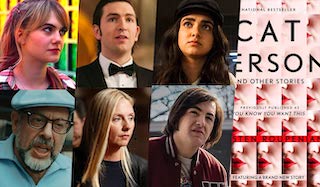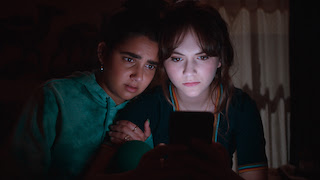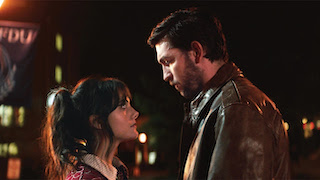 Goldcrest Post helped to prepare Cat Person for its recent world premiere at this year's Sundance Film Festival, providing comprehensive post-production services for director Susanna Fogel’s psychological thriller, which Deadline called “a must see.”
Goldcrest Post helped to prepare Cat Person for its recent world premiere at this year's Sundance Film Festival, providing comprehensive post-production services for director Susanna Fogel’s psychological thriller, which Deadline called “a must see.”
The facility handled both picture and sound finishing, with colorist Alex Berman working with Fogel to finalize the film’s look, and supervising sound editor/re-recording Mixer Eric Hirsch editing and mixing the soundtrack. Goldcrest Post’s sister company, Fancy House of Visual Effects, created dozens of finely crafted visual effects including a colony of ants. Goldcrest also provided dailies services during the production phase and offline editing suites to the film’s picture editor Jacob Craycroft and his crew.
Goldcrest Post is one of few boutique facilities capable of providing independent filmmakers with one-stop solutions for post. “Goldcrest Post’s excellent facilities, solid management and stellar talent made it a terrific choice,” said Cat Person’s producer Daniel Hank. “They consistently deliver high quality services across all areas of post and do so on schedule and on budget.”
Starring Emilia Jones, lead actress from CODA, last year’s Oscar winner for Best Picture, and Nicholas Braun, star of Emmy-winning series Succession, Cat Person centers on a pair of movie lovers whose dating relationship grows increasingly complicated. Vanity Fair praises the film for taking on “hot-button social issues” and predicts it is poised to catch “a mainstream wave.”
 The film makes subtle use of color to highlight twists in its narrative and to underscore its mood swings. Berman, taking direction from Fogel and Manuel Billeter, the film’s cinematographer, helped shape the look from the dailies phase. “Manuel and I discussed the tone and concept behind the look and created show LUTs for use in dailies,” Berman said. “He wanted to create a look that was close to the final look with flexibility to address changes that inevitably arise later in the process.”
The film makes subtle use of color to highlight twists in its narrative and to underscore its mood swings. Berman, taking direction from Fogel and Manuel Billeter, the film’s cinematographer, helped shape the look from the dailies phase. “Manuel and I discussed the tone and concept behind the look and created show LUTs for use in dailies,” Berman said. “He wanted to create a look that was close to the final look with flexibility to address changes that inevitably arise later in the process.”
Overall, Billeter was aiming for a rich, cinematic look with natural contrast. “We added a few points of blue and a couple points of green resulting in a subtle cyan, and made adjustments to that from scene to scene,” Berman noted. “Depending on the setting or the mood, we increased the green or brought in more warmth.”
Berman cites two scenes to illustrate his point. “Margot and Robert’s first date occurs in an old movie theatre with a façade of sparkling lights,” he said. “It’s golden, very pretty. An earlier scene involving Robert, Margot, and Margot’s teacher, played by Isabella Rossellini, has a different look. With those two beautiful women, the temptation was to make it look gorgeous, but the story dictated otherwise. The feeling between the characters is uncomfortable, and that’s reflected in the color. It happens in a sinister, cyan world.”
The tone of the narrative is also supported by sound design. Just as Berman did with color, Hirsch incorporated subtleties into the soundscapes to distinguish reality from fantasy and mirror the story’s menacing turn. “Part of my discussions with Susanna concerned how far to go in signaling that we’ve moved into the realm of fantasy, because it’s not always meant to be immediately obvious to the audience,” Hirsch says. “Often, we chose to merely hint at the change by adding sounds that contribute a feeling of unease or awkwardness.”
Many of the sounds that Hirsch used to suggest unease are subliminal. They appeal to the audience’s emotions without attracting notice. “A lot of the sound design has a musical element. We adjusted the tone or the pitch to achieve dissonance,” he explained. “It’s not something that registers consciously. Rather, you find yourself thinking, ‘What’s going on?’ It might be a rumble, like the start of an earthquake, although there’s no earthquake. It’s a way to add context to what’s happening between the people on the screen.”
 Hirsch collaborated with picture editor Jacob Craycroft, who was working in offline suites at Goldcrest, creating and modifying soundscapes as the picture took shape. “Jacob had done a lot of preliminary sound work on his own. We used that as a roadmap, making it bigger and more nuanced,” Hirsch recalled. “There’s a scene when Margot and Robert are on a date where the ambiance rises slowly, becoming increasingly claustrophobic. It works in tandem with the way the picture is cut until they both reach the breaking point. It’s one of my favorite scenes in the film.”
Hirsch collaborated with picture editor Jacob Craycroft, who was working in offline suites at Goldcrest, creating and modifying soundscapes as the picture took shape. “Jacob had done a lot of preliminary sound work on his own. We used that as a roadmap, making it bigger and more nuanced,” Hirsch recalled. “There’s a scene when Margot and Robert are on a date where the ambiance rises slowly, becoming increasingly claustrophobic. It works in tandem with the way the picture is cut until they both reach the breaking point. It’s one of my favorite scenes in the film.”
The visual effects team from Fancy House of Visual Effects was also involved in the project from its early days. VFX supervisor Randie Swanberg was on the set to consult with Fogel and her crew on scenes that required visual effects and to collect photogrammetry and lighting data.
One such scene involved a house that catches fire and burns to the ground. “For safety reasons, the size of the practical fire was restricted,” said Swanberg. “The fire was shot beautifully, but it needed to be bigger, so we added supplemental flames to the interior and exterior. The day following the fire, they shot the house smoldering. We also enhanced that shot by adding a dilapidated roof and scorch marks to windows.”
The VFX team’s most complex work involved a scene featuring a glass terrarium containing a colony of ants. “Several shots were designed to show the ants in extreme close up,” noted Swanberg. “The level of detail needed was incredible. Practical ant elements were shot as macro-photography with a snorkel lens and our job was to put them into the terrarium. The results were fantastic, but we needed a queen ant with wings. We solved that by adding CG wings to one of the ants. The wings were hairy and had a translucent outer shell. It was very challenging to pull it off, but our team did a remarkable job.”
Work on color, sound and visual effects overlapped and was often ongoing simultaneously. The fact that the digital intermediate theatre used by Berman and the mix stage, manned by Hirsch were in the same location was more than a convenience. It was crucial to finishing the project on a tight deadline. It also had creative benefits as Fogel could supervise a color session with Berman, they descend two flights of stairs to work with Hirsch on the mix.
Tight coordination was needed to align schedules and keep the pipeline running smoothly. “The communication I had with the conform team and visual effects was excellent,” said Berman. “I never had to ask for anything. As with any film, visual effects were constantly rolling in, but everything was delivered in the correct color space, so it fell right into the timeline. It was easy to grade incoming elements in the context of the film.”
“It was the same with sound,” he added. “Eric might be working on something, and Jacob or Susanna could pop into my room to check out a shot he had a question about. Boom! I could show it to him. Being in the same building made everything simpler.”
Hank says that having all aspects of the finishing process centered at Goldcrest Post relieved stress and resulted in a better film. “In post, things frequently change,” said. “Studios and producers have decision-making differences, sometimes to the last minute. Having all the elements and media on one server and under one team made things go faster and smoother.”
